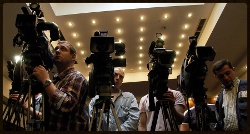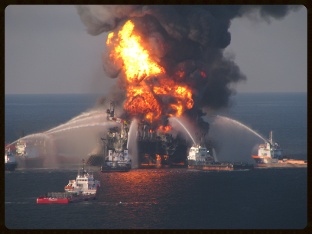Crisis Communications: Choosing the Right Spokesperson
Crises are a reality for any business, but thankfully few ever make the light of day.
While public-facing crises are few and far between – when they do arise they can do incalculable damage to a reputation that’s taken years to build. And in cases like these, the strength of a crisis communication response can make or break a company.
In this guide, we’ll explore some high-profile examples of crisis communication responses – both good and bad – and discuss why choosing the right person to represent an organisation can make all the difference.
An Introduction to Crisis Communication
Gutenberg PR’s Andria Barrera sums the term up nicely, stating:
“Crisis communications is defined as a sub-specialty of public relations. It is designed to protect and defend an individual, company, or organization that’s facing public challenge to its reputation.”
Crises can take many different forms, depending on the type of business, individual or other entity that’s involved. However, some common features of a crisis situation include:
· A situation that materialises rapidly or unexpectedly
· Time constraints
· The reputation of the involved party is at risk or damaged
· Urgent demands for information or responses
· Day-to-day business operations can be affected
The severity of the situation can also vary wildly and its extent will largely be defined by the particulars of the organisation involved. But despite the plentiful potential differences, there’s some staple advice that applies in almost any situation.
So without further ado, let’s delve into a couple of examples.
The Importance of Choosing a Spokesperson
After the message you choose to put out in response to a crisis, probably the most important factor is how you opt to deliver this.
It’s hard to overstate how crucial it is to choose an appropriate spokesperson to represent your company. But two very different cases can serve to illustrate the massive difference this can make:
Domino’s Pizza: Online Video ‘Prank’
In 2009, two Domino’s Pizza employees in the US posted video clips of them messing around in the kitchen. Their japes included one employee shoving bits of cheese up his nose, farting on salami and generally sullying produce.
These geniuses then opted to post the ‘prank’ video online and thanks to the power of social media within the space of a couple of days, ended up facing charges from police, well-deserved unemployment and fomenting one of the biggest crises ever to hit the company.
See a video summary of the incident here: https://www.youtube.com/watch?v=OhBmWxQpedI
Between the original video, news reports and duplicates – millions of views were racked up and Google search results were littered with references to the shocking events.
Fortunately, Domino’s had planned ahead and vice-president of communications Tim McIntyre stepped up to deliver a comprehensive response to the situation through a variety of channels.
As the problem originated on social media, this formed a key crux of Domino’s strategy as they scrambled to respond and fight viral with viral. And despite being somewhat slow on the uptake, within a couple of days, the company took to YouTube and Twitter (creating a stand-alone account to deal with the situation on the latter).
“The majority of people do recognise … that this was a rogue act of two individuals who thought they were being funny. That they do not represent this brand. That they do not represent the 100,000 people who work every day at Domino’s Pizza all over the world,” McIntyre said in response.
While Domino’s didn’t do everything right (e.g. not having a social media policy and strategy in place for this type of crisis), having the right spokesperson in the right place at the right time prevented a situation that was already spiralling rapidly from being further exacerbated.
BP: Deepwater Horizon
While we’ve covered this in further depth elsewhere, this case study provides an excellent foil to that of Dominos – illustrating that the wrong spokesperson can make an already-bad situation infinitely worse.
To briefly summarise, in 2010 an explosion on the BP Deepwater Horizon oil rig killed 11 people and flooded the surrounding ocean with millions of barrels of oil. As the crisis unfolded, CEO Tony Hayward was filmed watching his yacht compete in a race on the Isle of Wight.
From the get-go, Hayward was put into the media’s firing line, where he stumbled from failure to failure. He initially played down the extent of the spill, claiming that its environmental impact would be “very modest”.
However, within ten days he’d changed his tune greatly, describing the events at Deepwater horizon as an “environmental catastrophe”.
Hayward drew criticism for many of his statements in the wake of the crisis, but none more so than the famous “I’d like my life back” comment.
See Tony in action here: https://www.youtube.com/watch?v=tTxSlp3BKdc
The world was aghast at Hayward’s complacency in the face of such an unmitigated disaster, with President Obama’s chief of staff weighing in that Hayward certainly wouldn’t find a second career in PR consulting.
The Lessons
So what lessons can we glean from these two cases?
Put your best person forward: Don’t be blasé and simply pick someone just because they’re of sufficiently high status in the company (e.g. the CEO, MD or head of communications).
Instead, look for someone who is media trained, appears sympathetic and above all – is a good communicator. Tony Hayward might’ve been a fantastic administrator, but that didn’t help him when it came to representing his company under the harsh glare of the media.
While the presence of someone senior indicates you’re taking things seriously, as we’ve seen – simply selecting them by seniority can seriously backfire.
Plan for the worst: While both our examples failed to plan-out their responses to these scenarios in advance, Domino’s reaction was clearly the better thought-out.
While BP’s plan seemed to consist of wheeling around an apologetic Tony Hayward, Domino’s response wasn’t nearly as knee-jerk. After initially trying to track down the employees involved and remove the offending video, the company went on the offensive – meeting the crisis head-on on the social media channels from which it originated.
You know what type of crises are likely to affect your organisation, so take the time to think these through and plan out likely responses well in advance.
Test Your Spokesperson: While your chosen individual might look good on paper, there’s only one way to determine whether they’ll really cut the mustard and that’s to test them.
Stage mock interviews and hit them with challenging questions. Drill them on responses and invest in media training carried out by an experienced interviewer who can tackle issues like body language and phrasing.
The Bottom Line
Only you know how likely your organisation is to be hit by a crisis and what forms these are likely to take. But to summarise – there’s no such thing as being too prepared.
If you’ve got any questions about any of the cases we’ve discussed above, or want to share your thoughts on what makes a good spokesperson in a crisis – be sure to leave us a comment below or get in touch via Twitter .
And if you’re looking to extend the reach of your communications, don’t miss out on our free guide – where we compare the pros, cons and costs of various marketing and PR options for SMEs:
Selected industry experts bring you insight and expert advice, across a range of sectors.
Subscribe for free to receive our fortnightly round-up of property tips and expertise
Selected industry experts bring you insight and expert advice, across a range of sectors.
Subscribe for free to receive our fortnightly round-up of property tips and expertise




